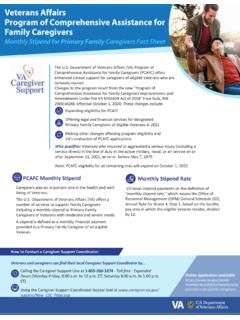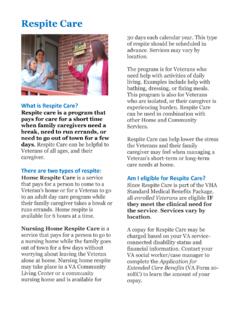Transcription of THE INFANT / TODDLER RESPONSIVE CAREGIVER CHECKLIST
1 THE IN FANT / TODDLER RESPONSI VE CAREGIVER CHECKLIST Part of Guiding Stars of Duval Resource Guide compiled by ELC of Duval Section 1 About the INFANT TODDLER RESPONSIVE CAREGIVER CHECKLIST (ITRCC) Section 2 ITRCC 15 Indicators Section 3 Basic examples for each indicator in the ITRCC Section 4 INFANT TODDLER Development & RESPONSIVE Care-giving process Section 5 Strategies for RESPONSIVE Care-giving, interactions and communication Section 6 Bibliography of Resources THE INFANT / TODDLER RESPONSIVE CARE GIVING CHECKLIST (ITRCC) GSOD Section 1 About ITRCC _____ Early Learning Coalition of Duval August 2013 - FINAL Page 2 of 34 The INFANT / TODDLER RESPONSIVE Care giving Checklis t (ITRCC) developed by the Missouri Quality Rating and Improvement System and adapted for Guiding Stars of Duval , is designed to measure care giving practices for groups of children ages from birth up to age 3 (3 6 months) in center based early childhood programs.
2 A minimum of 3 hours is required for valid assessment (may be a little under 3 hours in some cases based on the schedule). Further clarification and/or examples in this document for each indicator, are not meant to be all inclusive, but are pro vided to assist in tra ining purposes for assessors, coaches, and/or caregivers . RESPONSIVE care giving of very young children and infants is focused on each child as they develop a sense of well being, belonging, exploration, communication, and the contributions they make to their world. The learning of very young children and infants is multifaceted and integrated, rather than divided in separate content areas. Therefore, many of the items on the CHECKLIST happen during naturally occurring routines and events, rather than teacher led or directed activities for the whole group.
3 RESPONSIVE care giving is rooted deeply in relationships that are formed among children, families, primary caregivers , and peers. The indicators in the CHECKLIST measure what all care givers, and all children who are awake experience, rather than just what the lead CAREGIVER does or what one or two child re n experience. The intent is not that all children participate in the same activi ties at the same time, but rather that all child ren have opport unities to experience a wide vari ety of high quality intera ctions and experi ences thro ughout the day as they show intere st. The indicators do not ta rget a single child or a single CAREGIVER but capture the interactions and th e RESPONSIVE care-giving availa ble to all children in the classroom.
4 The points assigned to each indicator are organized around themes of cues (most important in INFANT / TODDLER care-giving), routines and activities becoming the ba sis for language and learning, and support for emotional needs of infants and toddlers. DEFINITIONS: CAREGIVER : when the term CAREGIVER is noted in the CHECKLIST , it is defined as teaching staff responsibl e for the care of the childre n. Volunteers, visitors , or floater staff who give the re gular staff member a short break (le ss than one hour in the care setting) are not considere d caregivers when assessing the group unless that person has an extre me negative interaction with a child or negatively impacts on the overall enviro nment.
5 Cues: following the INFANT or TODDLER s leads with pers onal attention and re spond based on the child s intere st and need Empathy: the ability to imagine how someone else is feeling in a particular situation and respond with care. Joint att ention: Si tuations in which care givers and infants and toddlers share the same fo cus and interest on an object or topic are referred to as episodes of joint attention. Routines are re peated, predictable events that pro vide a foundation for the daily tasks in a child s life. Teachers can create a predictable routine for infants and toddlers, and they can individualiz e those routines to match children s needs for sleeping and eating and to support childre n s development of self-r egulation.
6 Individualizing a routine means that the sequence is the same but the actions and timing may vary to accommodate the needs of individual children. Toddlers: includes 1 year olds and 2 year olds THE INFANT / TODDLER RESPONSI VE CARE GI VING CHECKLIST GSOD Section 2 ITRCC Indicators _____ Early Learning Coalition of Duval August 2013 - FINAL Page 3 of 34 INDICATORS Frequency, intensity, and quality of interaction and experience of the children during a 3-hour period (except #14) YES NO 1. Care givers recognize and respond appropriately to childre n s individualized cues. 2. Care givers use daily routines and interactions to form the basis for learning.
7 3. Care givers use joint attention with childre n during normally occurring routines and activities to demonstrate being RESPONSIVE to the child s interests. 4. Care givers narrate what is happening to childre n during routines and activities. 5. caregivers verbally help children anticipate familiar routines and events. 6. Care givers encourage positive peer interactions through modeling and arrangement of the environment. 7. caregivers help children identify and express their emotions. 8. Care givers encourage childre n to notice when their peers are expressing emotion. 9. Care givers model empathy or assist childre n in showing empathy toward s their peers. 10. Care givers support children s sense of competence by encoura ging them to do things for themselves as they are developmentally ready.
8 11. caregivers encourage children to solve their own problems. 12. caregivers provide children with a variety of opportunities to develop their gross motor skills. 13. caregivers provide children with a variety of opportunities to develop their fine motor skills. 14. Throughout daily interactions and natura lly occurr ing experiences, care givers encourage childre n to explore developmentall y appro priate concepts, such as: Comparing Quantities One-to-one Correspondence Volume Cause and Effect Object Permanence Compare and Contrast Opposites (Must observe a minimum of 4 different concepts being introduced and the children present should be involved) 15. Care givers engage in language play (s ongs, rh ymes, games) with childre n that introduce listening and responding.
9 SCORES SECTION Mark Y / N under each indicator only Ys get points I-1 I-2 I-3 I-4 I-5 I-6 I-7 I-8 I-9 I-10 I-11 I-12 I-13 I-14 I-15 Y / N Points 3 2 2 2 2 1 1 1 1 1 1 2 2 2 2 TOTAL POINTS (out of 25) ; Percentage:_____ Guiding Stars of Duval GSOD INFANT TODDLER Class rooms - Teacher Child Interact ion - RESPONSIVE Caregive r (ITRC) - 15% ITRCC Score - 70% to 75% ITRCC Score - 76% to 80% ITRCC Score - 81% to 85% ITRCC Score - 86% to 90% ITRCC Score - 91% to 100% Refer to the GSOD manual for additional information about how this tool fits into the star ratings ca lcu lation. THE INFANT / TODDLER RESPONSI VE CARE GI VING CHECKLIST GSOD Section 3 Basic Examples for each indicator in the ITRCC _____ Early Learning Coalition of Duval August 2013 - FINAL Page 4 of 34 1.
10 Examples of recognizi ng and responding to individualized cues include: An INFANT ru bs her eyes and the CAREGIVER picks her up, asks her if she is tire d, and sits in the ro cking chair with her. A TODDLER points to a cup on the counter and the CAREGIVER asks if he is thirsty and gives him a drink. A two year old is turn ing away and wiggling when the care giver is re ading a book to her. The CAREGIVER asks if she would ra ther go play and read the book later. 2. Examples of using daily routines and interactions to form the basis of learning include: An INFANT gives the CAREGIVER a toy and the CAREGIVER says, Emma, thank you for the blue truck! when saying thank you. W hile washing hands, the care giver te lls a TODDLER , We make the soap bubbles to get your hands clean and wash away germs.




